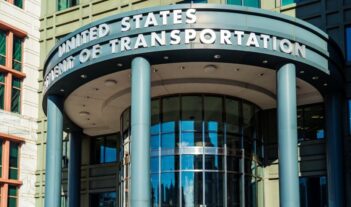
Policy experts argue that the U.S. Department of Transportation’s regulatory role should be reduced.
Citing failed projects such as the infamous “Bridge to Nowhere” in Alaska, which was never completed, critics for years have advocated a reduced role for the federal government in regulating surface transportation.
In a working paper issued by the Mercatus Center in 2013, for example, Tracy C. Miller and Brian Deignan argue that the U.S. Department of Transportation should abdicate its role in funding and regulating surface transportation and hand over the reins to states and non-governmental entities.
According to Miller and Deignan, Transportation Department regulations have not always stayed true to their objectives. For example, Miller and Deignan point out that the Department’s early construction of highways connecting suburbs to city centers destroyed urban homes and schools and divided neighborhoods and parks. Instead of supporting urban areas, they claim, the Department ended up neglecting the interests of urban residents.
Miller and Deignan also point to empirical studies showing the unintended harmful consequences of other federal transportation regulations. One study, for example, showed that many cities have received funding to build rail systems in recent years, despite bus systems generally being more cost-effective. Another study purportedly found that the agency mandating certain safety devices actually caused people to drive more aggressively, not less.
Miller and Deignan also claim that other government projects, although not strictly regulatory, have wasted government resources to please key political constituencies.
Even when the government addresses top priority projects, Miller and Deignan explain, it does not address them adequately. For example, when the government has expanded highway capacity to reduce congestion in certain areas, that expansion ultimately has increased demand during rush hour and has not improved traffic flow.
Miller and Deignan allege that policymakers make decisions influenced by their political aspirations, setting unreasonable regulatory goals simply to pander to constituents. These unreasonable goals can be costly, they argue, such as when the Federal Aviation Administration attempted to reduce risk by updating its air-traffic control system, but ultimately delayed system updates around the country.
Miller and Deignan acknowledge that transportation safety advocates view the Transportation Department’s regulations as necessary and beneficial to “reduce pain” and prevent “family disruption,” benefits that cannot be quantified. But according to Miller and Deignan, safety advocates focus on the insignificant per-unit cost of implementing the agency’s standards compared to the number of lives that Transportation Department regulations save. Moreover, proponents of federal transportation regulations argue that the existence of the Department alone poses enough deterrent threat to prevent manufacturers from offering risky products.
Responding to regulation proponents, Miller and Deignan highlight the success of economic deregulation of the freight market during the 1970s and early 1980s, which they claim reduced human and material loss.
To fill the void of federal deregulation, Miller and Deignan encourage state transportation departments to continue increasing their focus on traffic and safety. Although state transportation departments are focused primarily on highways and roadway construction and maintenance, they have also provided funding, training, and data analysis at the local level. Miller and Deignan support this arrangement because “in many states at least half of all serious automobile crashes occur on locally administered roads.”
Miller and Deignan also approve of state oversight of local road conditions and local safety initiatives such as information-safety campaigns and public-service announcements and posit that states are motivated to build attractive highways in order to attract tourists.
Furthermore, Miller and Deignan suggest that, instead of the Transportation Department mandating particular levels of safety, manufacturers should set safety levels based on customers’ risk preferences. They reason that the government need not publish its own safety information, since private initiatives such as the Kelly Blue Book and CarMD already provide valuable information to consumers.
Miller and Deignan also propose that insurance companies could fill any void created by a decreased federal government presence. Insurers could investigate their policyholders’ safety practices and provide incentives for automobile manufacturers to implement safety measures by charging different premiums based on the car’s level of safety. Given that insurance companies already charge different premiums based on the make and model of cars, taking on a larger role in promoting safety would not overburden these companies.
Miller and Deignan cite the U.S. Constitution’s Commerce Clause as evidence that the federal government can regulate interstate commerce, but they argue that, nevertheless, regulation of local commerce should be left to state and local governments. They argue that state and local governments should be responsible for providing public-transit subsidies because they would manage them in a more efficient way than federal governments by capturing the value in property taxes in the affected areas.
Moreover, Miller and Deignan recommend reducing or eliminating federal gas taxes and allowing states to adjust their fuel tax rates to replace the revenue currently provided by the federal government. They claim that the marginal cost of fuel taxes to drivers is not sufficient to alleviate traffic congestion and wasted fuel. In addition, they say that federal fuel taxes have become even less effective as vehicles have become more fuel efficient. They also theorize that reducing federal transit service subsidies would encourage cities to promote the development of low-cost alternatives.
Ultimately, Miller and Deignan assert that, because bureaucratic decision makers lack the necessary information to make informed regulatory decisions, the Transportation Department should refocus its resources in order to eliminate barriers to market competition and allow state transportation departments to carry out this role more effectively.
Miller and Deignan’s paper was posted to the Social Science Research Network’s repository in 2018 but appears to remain an unpublished working paper.



